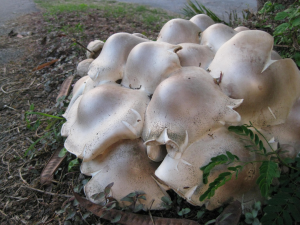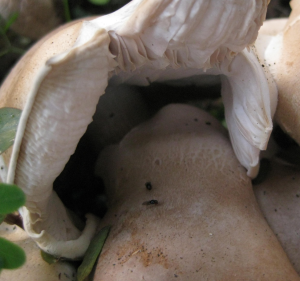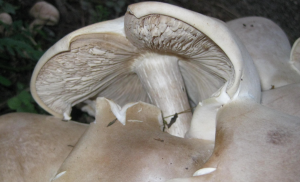
After a few days, mushrooms were open:

I spied a couple of flies: suspect they are the spore vectors.

I wanted to take a peak under the umbrella:

K Satake, K Shimazaki, Y Tsuji, K Ueda. Time and size of a giant earthquake in Cascadia inferred from Japanese tsunami records of January 1700. Nature 379, 246-249 (1996).
GEOLOGICAL evidence shows that great earthquakes have occurred in the recent prehistoric past in the Cascadia subduction zone, off the Pacific coast of North America. The most recent event (or series of events) is dated at about 300 years ago, but the precise date and magnitude have not been determined. Geological investigations have not been able to distinguish a single giant earthquake from a series of great earthquakes occurring over a timespan of a decade or two4, although this information is important for the assessment of future hazard. We have found several tsunami records in Japan from AD 1700 with no indication of a local cause. Historical earthquake records and palaeoseismic evidence indicate the absence of a large earthquake in 1700 in South America, Alaska or Kamchatka, leaving Cascadia as the most likely source of this tsunami. The estimated time of the earthquake is the evening (about 21:00 local time) of 26 January 1700. The magnitude is estimated as 9 from the tsunami heights, in which case the earthquake ruptured the entire length of the Cascadia subduction zone2. These estimates are consistent with Native American legends that an earthquake occurred on a winter night.
The stories were told between 1860 and 1964. Figure 2 tabulates the accounts
and gives estimated date ranges. Date range minima and maxima are 1400 and 1825. All estimates span the interval between 1690 and 1715, and the average value of the mid-points of the date ranges is 1690. Discarding the earliest and latest midpoints yields an average midpoint date of 1701. This is remarkably consistent with the 1700 date of the most recent CSZ earthquake.
Here is a list of the historical 24 earthquakes of highest magnitude,
from Wikipedia. Notice that on the very day of the 7th Earthquake,
this was added to the Wikipedia record.
| Pos. | Date | Location | Name | Magnitude |
|---|---|---|---|---|
| 1 | May 22, 1960 | Valdivia, Chile | 1960 Valdivia earthquake | 9.5 |
| 2 | March 27, 1964 | Prince William Sound, USA | 1964 Alaska earthquake | 9.2 |
| 3 | December 26, 2004 | Sumatra, Indonesia | 2004 Indian Ocean earthquake | 9.1 |
| 4 | November 4, 1952 | Kamchatka, Russia (then USSR) | Kamchatka earthquakes | 9.0 1 |
| 5 | August 13, 1868 | Arica, Chile (then Peru) | 1868 Arica earthquake | 9.0 2 |
| 6 | January 26, 1700 | Pacific Ocean, Japan and USA and Canada | 1700 Cascadia earthquake | 9.03 |
| 7 | March 11, 2011 | Sendai, Japan | 2011 Sendai earthquake | 8.94 |
| 8 | February 27, 2010 | Maule, Chile | 2010 Chile earthquake | 8.8 |
| 9 | January 31, 1906 | Ecuador–Colombia | 1906 Ecuador-Colombia earthquake | 8.8 |
| 10 | November 25, 1833 | Sumatra, Indonesia | 1833 Sumatra earthquake | 8.8 |
| 11 | February 4, 1965 | Rat Islands, Alaska, USA | 1965 Rat Islands earthquake | 8.7 |
| 12 | November 1, 1755 | Lisbon, Portugal | 1755 Lisbon earthquake | 8.7 5 |
| 13 | July 8, 1730 | Valparaiso, Chile | 1730 Valparaiso earthquake | 8.7 6 |
| 14 | March 28, 2005 | Sumatra, Indonesia | 2005 Sumatra earthquake | 8.6 |
| 15 | March 9, 1957 | Andreanof Islands, Alaska, USA | 1957 Andreanof Islands earthquake | 8.6 |
| 16 | August 15, 1950 | Assam, India – Tibet, China | 1950 Medog earthquake | 8.6 |
| 17 | September 12, 2007 | Sumatra, Indonesia | September 2007 Sumatra earthquakes | 8.5 |
| 18 | October 13, 1963 | Kuril Islands, Russia (USSR) | 1963 Kuril Islands earthquake | 8.5 7 |
| 19 | February 1, 1938 | Banda Sea, Indonesia (Dutch East Indies) | 1938 Banda Sea earthquake | 8.5 |
| 20 | February 3, 1923 | Kamchatka, Russia (USSR) | Kamchatka earthquakes | 8.5 7 |
| 21 | November 11, 1922 | Atacama Region, Chile | 1922 Vallenar earthquake | 8.5 8 |
| 22 | May 24, 1751 | Concepción, Chile (Kingdom of Chile) | 1751 Concepción earthquake | 8.5 |
| 23 | October 20, 1687 | Lima, Peru (Viceroyalty of Peru) | 1687 Peru earthquake | 8.5 |
| 24 | December 16, 1575 | Valdivia, Chile (Kingdom of Chile) | 1575 Valdivia earthquake | 8.5 |
 [/caption]
[/caption]